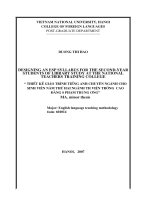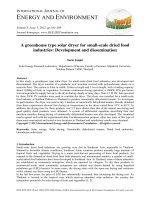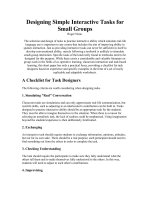Designing Simple Interactive Tasks for Small Groups
Bạn đang xem bản rút gọn của tài liệu. Xem và tải ngay bản đầy đủ của tài liệu tại đây (108.68 KB, 8 trang )
Designing Simple Interactive Tasks for
Small Groups
Roger Nunn
The selection and design of tasks to practise interactive ability which simulate real-life
language use is important to any course that includes the aim of improving ability in
spoken interaction. Just as providing interactive tasks can never be sufficient in itself to
develop conversational ability, merely following a textbook is unlikely to stimulate small-
group interaction. Specific tasks of the kind rarely found in textbooks need to be designed
for this purpose. While there exists a considerable and valuable literature on group-work in
the fields of co-operative learning, classroom interaction and task-based learning, this short
paper has only a practical focus, providing a checklist for task designers based on
experience and specific examples in the form of a set of easily replicable and adaptable
worksheets.
A Checklist for Task Designers
The following criteria are worth considering when designing tasks.
1. Simulating "Real" Conversation
Classroom tasks are simulations and can only approximate real-life communication, but
real-life skills, such as adjusting to an interlocutor's contribution can be built in. Tasks
designed to practise interactive ability should be an appropriate task for the students. They
must be able to imagine themselves in the situation. When there is a reason for selecting an
unrealistic task, the lack of realism could be emphasized. Using imagination beyond the
students'experience is then deliberately forefronted.
2. Exchanging
An interactive task should require students to exchange information, opinions, attitudes, but
not for its own sake. There should be a real purpose; each participant should need to find
something out from the others in order to complete the task.
3. Checking Understanding
The task should require the participants to make sure they fully understand what the others
tell them and to make themselves fully understood to the others. In this way, students will
need to adjust to each other's contributions.
4. Improvising
The task should require both predictable and unpredictable communication. Real
conversation always involves unpredictability so an ability to improvise needs to be
practised. For example, an attempt to come to an agreement is unpredictable. There is no
requirement to actually reach an agreement, so the participants may develop the
conversation freely. On the other hand, they must exchange the information for an
agreement to be possible and cannot easily avoid asking questions.
5. Equal Opportunity
Where possible, the task should allow participants (and definitely exam candidates) an
equal opportunity to structure the conversation. Ideally, they should have equal access to
important features of turn-taking such as self-selection and nomination and should be able
to initiate, negotiate and follow up other participants` contributions. Care must therefore be
taken not to devise assessment tasks that require or encourage the adoption of unequal roles
in conversation (unless, of course, it is specifically designed to practise unequal social
roles, such as boss-employee, etc).
6. Mixed-Ability
For mixed-ability courses, tasks should favour the production of contributions of all kinds.
They should allow both weak and strong participants to extend themselves to their full
ability. For strong participants, making themselves understood to students with less
linguistic ability is a useful skill in itself. Opportunity and time must be available for
candidates to hold the floor and produce longer contributions where appropriate, but they
should also have the opportunity to use short conversational phrases reacting to the
contributions of other speakers. Less able students should still be able to accomplish at
least the first part of the task at their own level.
7. Models
Models of performance can be provided by making recordings of tasks using competent
speakers of the language (not necessarily native speakers). These can be used for listening
activities that focus on skills such as turn-taking or pronunciation, and language that
students themselves can use.
8. Time Constraints
Reasonable time constraints should be imposed. A group of three students would normally
require about 15-20 minutes to do the sample task below, although up to one hour of class
time may be needed overall, taking preparation and follow-up activities into account.
9. Outcomes
Interactive activities are still pedagogical tasks and, as such, should have outcomes or
results. Tasks for classroom instruction should have the potential for either a performance
or a "report-back" phase, during which students could write a report or (a) group
spokesperson(s) could report back to the class. This provides the opportunity for recycling
language used in the task and for remedial work on language problems that arise during the
task. At this stage, the teacher may wish to engage in techniques for correcting language
and might want to correct even the smallest errors in pronunciation, lexis or grammar. This
counteracts the potentially negative effects of free communication, such as pigeonization,
"local speak", such as "katakana English" in Japan, etc.
10. Language Practice
The tasks will normally have some predictable features of language. Vocabulary on the
topic has probably been taught using a textbook/worksheet, probably in a reading and/or
listening activity. Students can be given intensive practice in language functions such as
giving advice, expressing opinions, asking different kinds of questions. Interactive tasks
provide practice, but are unlikely to lead to long-term learning if taught in isolation. They
are integrated into courses involving all language skills. They support and are supported by
exercises that focus on form or literacy skills.
11. Simple and Re-Usable
Teachers are busy people. As far as possible, tasks should be designed so that they are
simple and self-explanatory. They should be modifiable (on a word-processor) and re-used,
possibly even with the same class for revision or assessment. While they may be simple, it
is useful to build in a feature to help the teacher discover how well an independent task has
been done at the report back stage. In the sample task below, for example, the
accommodation is sometimes free. A full discussion would inevitably involve discussion
about why. (Some work is expected in return.) A group that does not discuss this point has
not really fully exchanged information.
12. Student Input
After using the teacher-written sheets students should have the opportunity to make their
own sheets for a future activity on the same topic. Task repetition is an important feature of
a learning cycle and student input improves motivation.
13. Assessment
Rating scales are an appropriate means of assessing interactive performance and helping
students to become aware of their own ability, in order to set aims for future performances.
Activities that are not assessed run the risk of being given low priority by students.
A Sample Task "A Happy Person"
The following materials set up a series of activities, leading to a free conversation stage.
The same basic table is used throughout.
Task Preparation
Listening. (Optional)
1. The teacher talks about a Happy Person s/he knows well while students make notes in
the following table. It as also possible to ask colleagues to record a monologue using the
same categories to describe a real or imaginary "Happy Person".
A Happy Person
Listen to the teacher describing a real or imaginary HAPPY person. Make notes
in the table below.
Name
Age
Job
Accommodation
Family
Hobbies
Opinion
2. Two teachers record a conversation talking about different people. They exchange
information by asking and answering questions about the categories in the left hand column
of the table, discuss the information briefly, and then try to decide which person is
happiest. Students make notes in the table. It is also useful to design activities which
require students to listen and identify questions asked by the speakers.
Listen to Roger and Darren talking about two "happy" people and make notes in the table.
Roger Darren
Name
Age
Accommodation
Family
Hobbies
Opinion
Which one do they decide is the happiest and why? Do you agree?
Language Practice
Questions of various kinds are needed for the speaking activity. This could include
standard questions such as "How old is Pierre?", short conversational questions such as
"What about Pierre?" once age has been established as the topic, or indirect questions such
as "Do you know how old Pierre is?" Different question forms have already been
demonstrated in the listening activities, but may be targeted for intensive preparation
before the pair and group conversation stage.
Question Practice. A Happy Person
Complete the following questions and then write another possible question in each box:
Name What
Age How
Accommodation What kind of
Family What can you tell me
Hobbies What
Opinions Does
Possible key
Name What’s the name of your "happy person"?
Age
How old is s/he?
Do you know how old s/he is?
Accommodation
What kind of accommodation does s/he live in?
Can you describe their home?
Family
What can you tell me about his/her family?
Does s/he have a large family?
Hobbies
What does s/he do in her/his free time?
What about his/her hobbies?
Opinions
Does s/he have anything interesting to say about "happiness"?
What does s/he think leads to a happy life?
Setting up the Group Speaking Task in Stages
After the listening and language exercises have been completed, the students should have a
repertoire of questions available to them for exchanging information on the topics they will
need. The following steps are intended to bring about a smooth transition into an
independent small-group conversation between three or four students.









